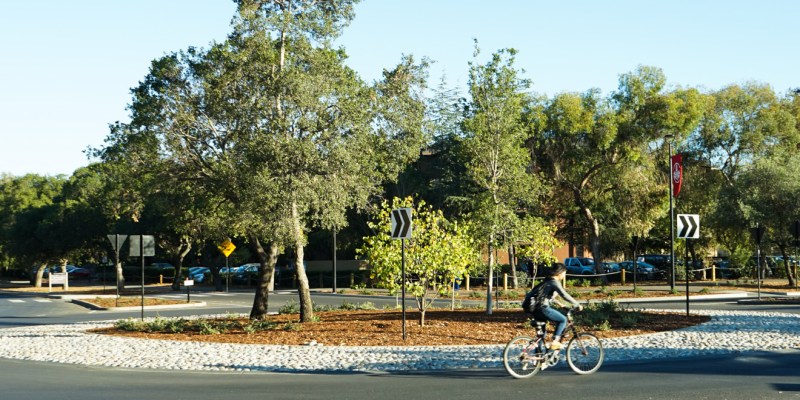We have come a long way from the first pilot roundabout at Stanford in 2014 to six roundabouts in full operation on the main campus today. Roundabouts are designed to promote a continuous, circular flow of traffic to improve safety, so why do some people continue to use the outdated “Circle of Death” reference? Today, real roundabouts deserve to be rebranded as Circles of Life!
Roundabouts are designed to improve safety for drivers, pedestrians and bicyclists at points of convergence in busy intersections. Studies have shown that roundabouts are safer than traditional stop signs or traffic signal-controlled intersections. They work primarily by reducing vehicle speed, forcing pedestrians, bicyclists and drivers alike to pay greater attention to traffic and making it clear who has the right of way.
There may be a short learning curve on how to navigate roundabouts, but the benefits are plentiful. Roundabouts have far fewer conflict points compared to traditional intersections, and they are relatively intuitive by design.
Creative roundabouts at Stanford
Stanford’s roundabouts address the special traffic and travel patterns on campus. For instance, the roundabout on Galvez Street at Arboretum Road has a bypass lane that enables vehicles to avoid the roundabout entirely if the driver is heading north on Galvez Street and their destination is El Camino Real. This maintains traffic flow at peak commute hours and during special events on campus, like Cardinal football games.
On Jane Stanford Way, the multiple mini-roundabouts were upgraded by Campus Planning & Design in 2020. The improvements include directional signage on sidewalks and a wider circumference to accommodate students during breaks when ridership is high.
Kudos to our Project Management and Campus Planning & Design Team for initiating roundabouts at Stanford and creating what will be a legacy of landmarks throughout campus!
Show me the data
On a national level, roundabouts reduced injury crashes by 75% at intersections where stop signs or traffic signals were previously used for traffic control, according to a study by the Insurance Institute for Highway Safety (IIHS).
Studies by the IIHS and Federal Highway Administration (FHWA) have shown that roundabouts typically achieve the following:
- 37% reduction in overall collisions
- 75% reduction in injury collisions
- 90% reduction in fatality collisions
- 40% reduction in pedestrian collisions
Ride right in the “Circles of life”
Roundabouts work best when all users know how to navigate them. Here are three simple steps to take:
- Slow down and yield to those in the roundabout.
- Proceed when clear, going to the right.
- Exit using caution, giving the right of way to pedestrians in the crosswalks.
Stanford tips on navigating roundabouts
We recently published a Getting Around Campus Safely article with more details and helpful tips for navigating roundabouts, whether you are riding, walking or driving. We also have a dedicated webpage with resources: Get Around Safely.
To help new students start off on the right foot, we offered a hands-on workshop on roundabouts and how to ride around Marguerite buses on campus. Students sat in the Marguerite driver’s seat, using the bus’ mirrors to see fellow students riding around the bus. It was an eye-opening experience, which you can learn more about in our “New Stanford Students Learn to Navigate Roundabouts and Buses” article.
Remember — we are all in this together and that is what makes it the circle of life: a roundabout way to arrive safely at our next destination. Can we count on you to ride the right way too? It is one way to ensure you meet up unscathed to enjoy that slice from Treehouse!
Ariadne Delon Scott is the Assistant Director of Active Mobility for Stanford Transportation and manages the bike safety program. She can be reached at [email protected].
